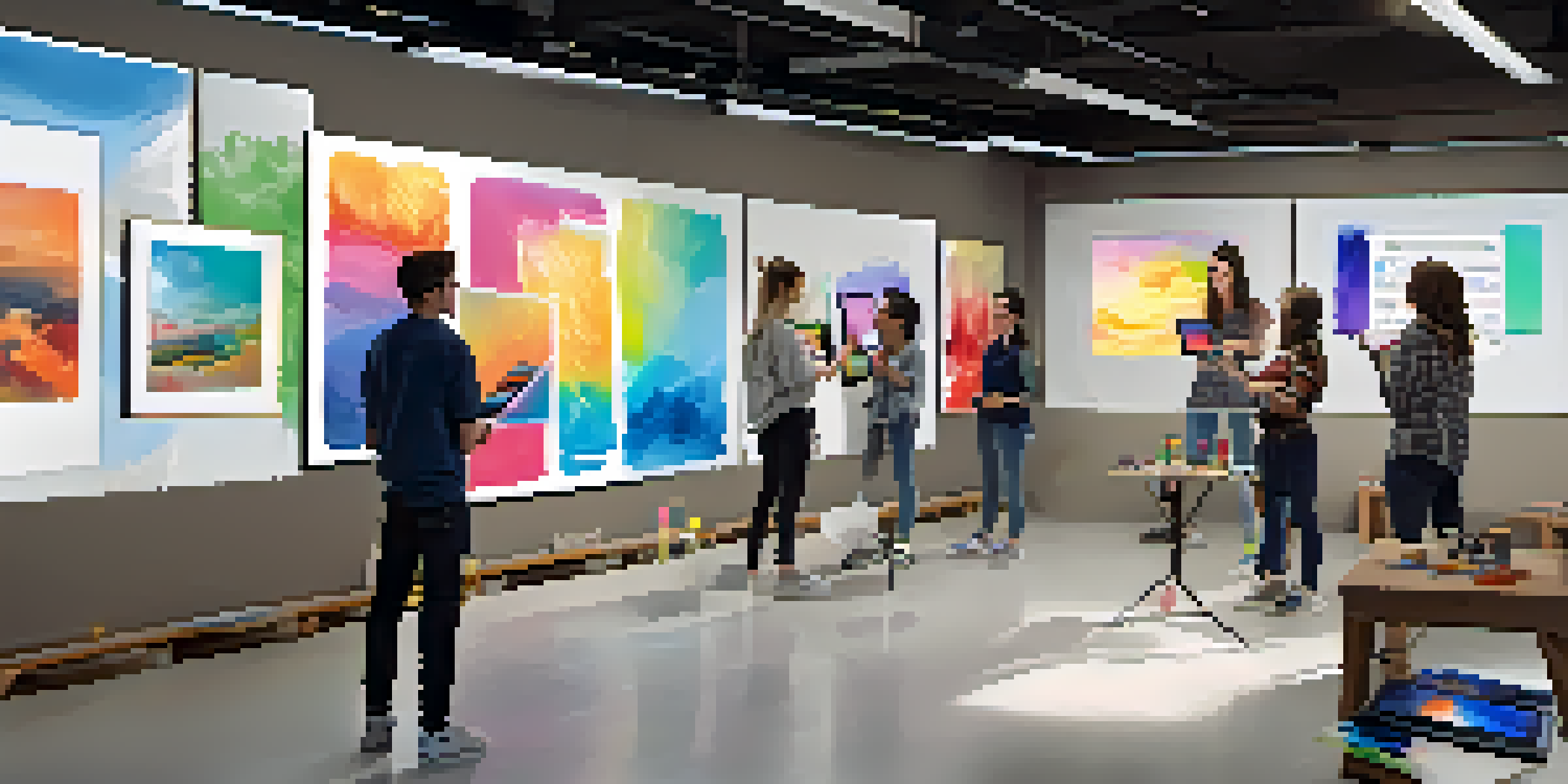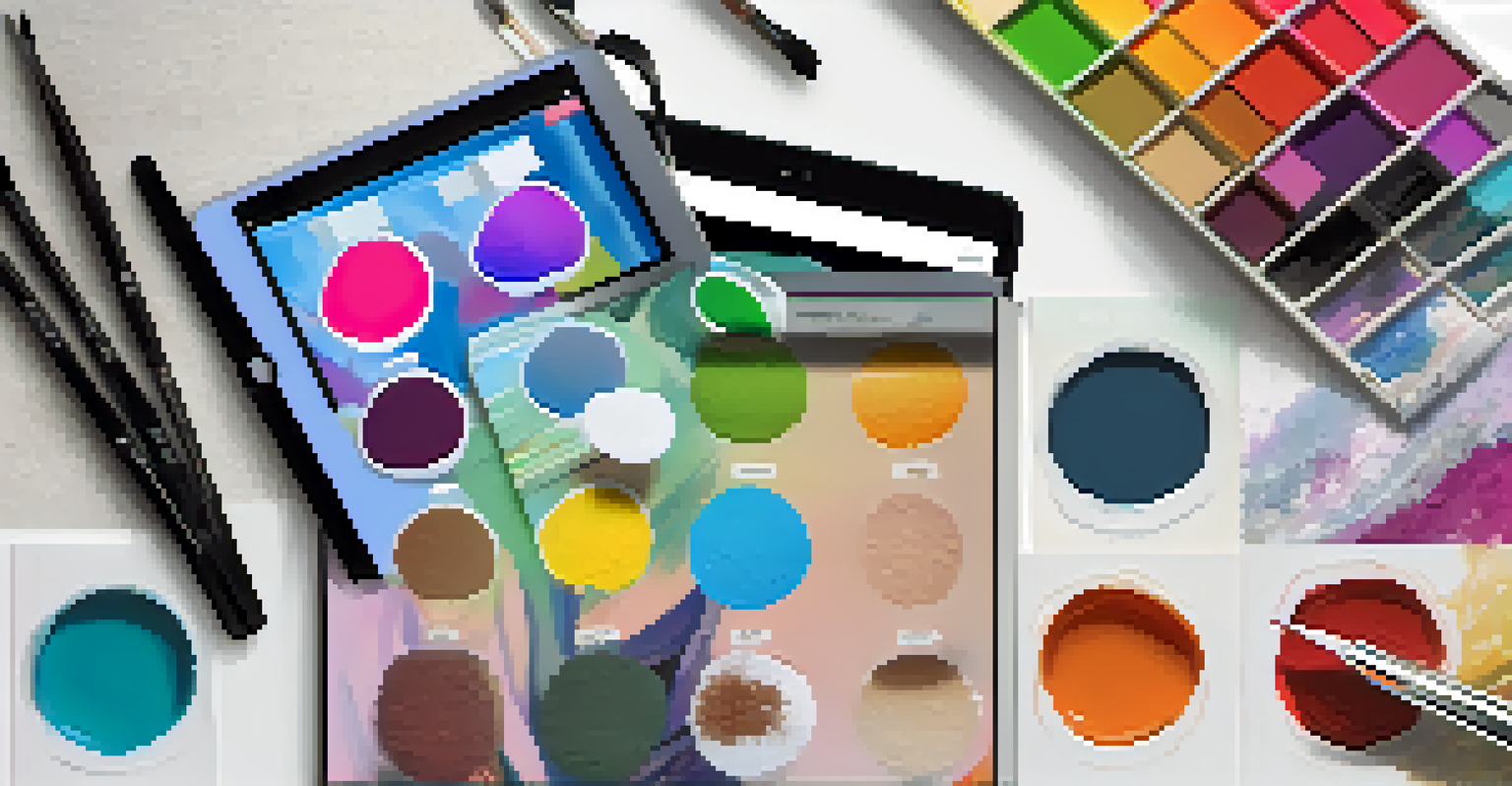Using Digital Tools to Enhance Traditional Painting Lessons

The Intersection of Tradition and Technology in Art Education
In today's art education landscape, blending traditional painting techniques with digital tools opens up a world of possibilities. Imagine teaching a classic oil painting technique while also demonstrating how to use a digital palette. This intersection not only enhances learning but also makes art more accessible to students of all backgrounds.
Art is not freedom from discipline, but disciplined freedom.
Traditional methods have their charm, but integrating digital resources can spark creativity and innovation. For instance, using apps that simulate different paint textures can help students visualize their work before committing to the canvas. This allows for experimentation without the fear of wasting materials, encouraging a more playful approach to art.
As educators, we can harness the power of technology to enrich the learning experience. By introducing digital tools, we create an inviting environment where students feel empowered to explore their artistic voice while developing foundational skills. This fusion of old and new prepares students for a future where technology and art coexist harmoniously.
Virtual Demonstrations: Bringing Artists to the Classroom
One of the most exciting aspects of digital tools is the ability to connect students with artists from around the world through virtual demonstrations. Imagine a renowned painter guiding your class through a live session, sharing tips and techniques in real-time. This not only inspires students but also provides them with insights that might be difficult to access otherwise.

These online sessions can be recorded and revisited, allowing students to learn at their own pace. For example, students can pause and rewind a demonstration to fully absorb complex techniques or revisit their favorite parts. This flexibility accommodates various learning styles, ensuring that no one feels left behind.
Merging Tradition with Technology
Blending traditional painting techniques with digital tools enhances creativity and accessibility in art education.
Moreover, virtual demonstrations foster a sense of community among students. They can engage in discussions, share their progress, and even collaborate on projects, all while feeling connected to the broader art world. This collaborative spirit encourages students to take risks and push their creative boundaries.
Digital Tools for Planning and Concept Development
Before diving into a painting, planning is crucial, and digital tools can make this process more efficient and interactive. Software like Adobe Fresco or Procreate allows students to sketch and experiment with color palettes before they even touch a paintbrush. This step can lead to more thoughtful and deliberate artwork.
The artist is not a different kind of person, but every person is a different kind of artist.
Using digital platforms, students can also create mood boards or reference collages easily. For example, they can gather images, textures, and color inspirations from various sources online, giving them a comprehensive visual roadmap for their projects. This method not only enhances creativity but also encourages research and exploration.
Additionally, these tools often come with features that help students experiment with different compositions. By manipulating their designs digitally, they can see what works best before committing to their final piece. This kind of iterative process is beneficial in building confidence and refining artistic skills.
Augmented Reality: A New Dimension to Painting Lessons
Augmented Reality (AR) is transforming art education by overlaying digital information onto the real world. Imagine students using their tablets to visualize how a painting would look on their own wall before even picking up a brush. This technology provides immediate feedback and encourages thoughtful decisions about composition and color.
AR can also facilitate interactive learning experiences. For instance, students can point their devices at their artwork to see tutorials, color theory explanations, or even historical context about their chosen techniques. This immersive experience not only makes learning more engaging but also deepens their understanding of art.
Benefits of Virtual Demonstrations
Connecting students with artists through virtual demonstrations inspires learning and fosters a sense of community.
Furthermore, AR can help students visualize the steps involved in various painting techniques. By breaking down complex processes into digestible, visual segments, students can grasp intricate techniques without feeling overwhelmed. This hands-on approach to learning fosters confidence and mastery in their craft.
Online Collaboration: Fostering Creativity and Community
Digital tools enable students to collaborate on projects in ways that were previously unimaginable. Platforms like Google Jamboard or Trello allow budding artists to share their ideas, receive feedback, and work together on virtual canvases. This collaborative spirit nurtures creativity and builds a sense of community among young artists.
By engaging in group projects and discussions online, students can learn from each other's perspectives and techniques. For example, a student might introduce a unique approach to color mixing, inspiring others to experiment with their own styles. This shared learning experience enriches their educational journey and encourages a culture of support.
Additionally, online collaboration can extend beyond the classroom. Students can connect with peers from different schools or even countries, broadening their artistic horizons. These interactions not only enhance their skills but also cultivate friendships that last beyond their art classes.
Digital Portfolios: Showcasing Artistic Growth
In the digital age, having an online portfolio is essential for artists. Digital tools allow students to create stunning portfolios that showcase their work, track their progress, and reflect on their artistic journey. This not only highlights their accomplishments but also serves as a valuable resource for future opportunities.
Constructing a digital portfolio encourages students to curate their best work thoughtfully. They can include images, descriptions, and even videos of their creative process. This reflective practice helps them articulate their artistic vision and intentions, which is crucial for personal and professional growth.
Empowering Through Digital Portfolios
Creating digital portfolios allows students to showcase their artistic growth and increases their opportunities in the art world.
Moreover, digital portfolios can be shared easily with potential employers, galleries, or schools. This accessibility broadens their reach and enhances their chances of being noticed in the competitive art world. By combining traditional skills with modern tools, students set themselves up for success in their artistic careers.
Conclusion: Embracing Change in Art Education
As we navigate the evolving landscape of art education, integrating digital tools with traditional painting lessons is essential. By embracing these technologies, educators can enhance creativity, foster collaboration, and prepare students for the future. The combination of both worlds creates a richer, more diverse learning experience.
While traditional techniques remain vital, the incorporation of digital resources allows students to explore new dimensions of their creativity. This hybrid approach encourages experimentation, innovation, and a deeper understanding of art. It’s about finding balance and recognizing that both methods can coexist beautifully.

Ultimately, the goal is to inspire the next generation of artists. By equipping them with the skills to navigate both traditional and digital realms, we empower them to express their unique voices in a rapidly changing world. Let's embrace this journey together, transforming art education for the better.